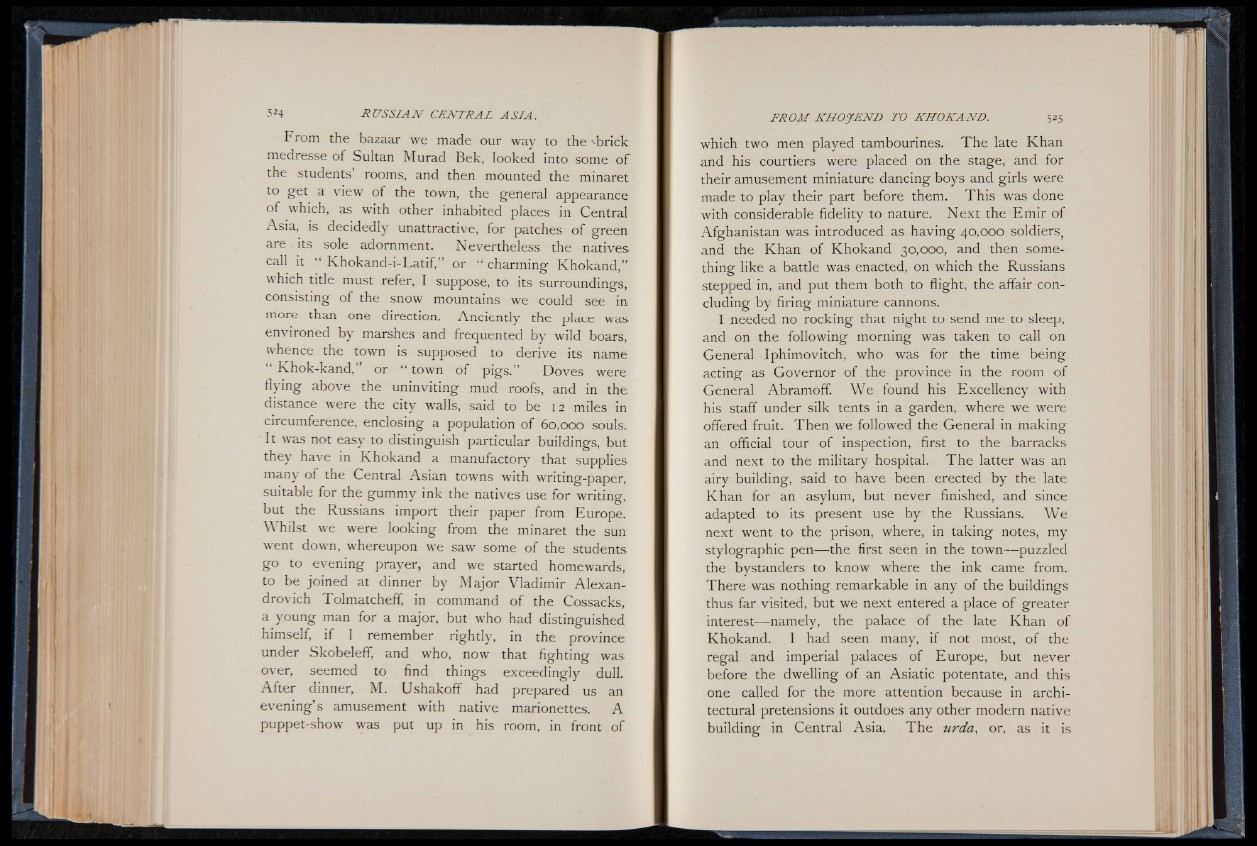
From the bazaar we made our way to the '-brick
medresse of Sultan Murad Bek, looked into some o f
the students’ rooms, and then mounted the minaret
to get a view of the town, the general appearance
o f which, as with other inhabited places in Central
Asia, is decidedly unattractive, for patches of green
are its sole adornment. Nevertheless the natives
call it “ Khokand-i-Latif,” or “ charming Khokand,”
which title must refer, I suppose, to its surroundings,
consisting of the snow mountains we could see in
more than one direction. Anciently the place was
environed by marshes and frequented by wild boars,
whence the town is supposed to derive its name
Khok-kand, or “ town of pigs. Doves were
flying above the uninviting mud roofs, and in the
distance were the city walls, said to be 12 miles in
circumference, enclosing a population of 60,000 souls.
It was not easy to distinguish particular buildings, but
they have in Khokand a manufactory that supplies
many of the Central Asian towns with writing-paper,
suitable for the gummy ink the natives use for writing,
but the Russians import their paper from Europe.
Whilst we were looking from the minaret the sun
went down, whereupon we saw some of the students
go to evening prayer, and we started homewards,
to be joined at dinner by Major Vladimir Alexandrovich
Tolmatcheff, in command of the Cossacks,
a young man for a major, but who had distinguished
himself, if I remember rightly, in the province
under Skobeleff, and who, now that fighting was
over, seemed to find things exceedingly dull.
After dinner, M. Ushakoff had prepared us an
evening’ s amusement with native marionettes. A
puppet-show was put up in his room, in front of
which two men played tambourines. The late Khan
and his courtiers were placed on the stage, and for
their amusement miniature dancing boys and girls were
made to play their part before them. This was done
with considerable fidelity to nature. Next the Emir of
Afghanistan was introduced as having 40,000 soldiers,
and the Khan of Khokand 30,000, and then something
like a battle was enacted, on which the Russians
stepped in, and put them both to flight, the affair concluding
by firing miniature cannons.
I needed no rocking that night to send me to sleep,
and on the following morning was taken to call on
General Iphimovitch, who was for the time being
acting as Governor of the province in the room of
General Abramoff. We found his Excellency with
his staff under silk tents in a garden, where we were
offered fruit. Then we followed the General in making
an official tour of inspection, first to the barracks
and next to the military hospital. The latter was an
airy building, said to have been erected by the late
Khan for an asylum, but never finished, and since
adapted to its present use by the Russians. We
next went to the prison, where, in taking notes, my
stylographic pen— the first seen in the town— puzzled
the bystanders to know where the ink came from.
There was nothing remarkable in any of the buildings
thus far visited, but we next entered a place of greater
interest— namely, the palace of the late Khan of
Khokand. I had seen many, if not most, of the
regal and imperial palaces of Europe, but never
before the dwelling of an Asiatic potentate, and this
one called for the more attention because in architectural
pretensions it outdoes any other modern native
building in Central Asia. The urda, or, as it is